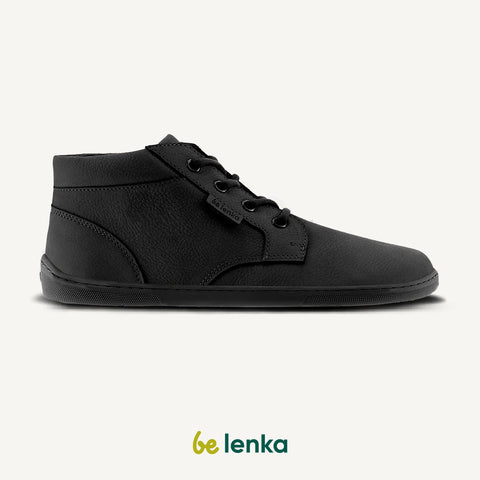When most people think of barefoot shoes, they may think of thin soled shoes that make the feet muscles work harder than their heavily cushioned sneaker counterparts.
This is accurate, but it's not the full scope of what sets barefoot shoes apart in their ability to promote good foot health.
Arguably, the most essential element of a barefoot shoe isn't having a thin sole; it's having wide toe box shoes. To be clear, the toe box is the area that begins at the knuckle of the toes in a shoe and extends down to cover the entire toes.
Most shoes have a tightly enclosed toe box to the extent that it's difficult to wiggle the toes, yet alone move them, and this restricted toes movement can lead to bigger issues down the line.
Why Are Narrow Toe Boxes Harmful?
If you're unsure if the toe boxes on your shoes are narrow enough to cause harm, a better question to ask yourself may be what is the ideal toe box width for optimal foot health.
There's little doubt in most people's minds that overly narrow shoes are damaging. Not only are they extremely uncomfortable with extended use, but they can lead to both foot problems and whole body concerns.
The Consequences of Narrow Toe Boxes
To start with, there's a high likelihood of developing blisters on the sides of the pinky toes in shoes that are too tight. Ingrown toenails are another common issue that arises with tight toe boxes as it can press the toenails into the lateral folds or side walls to the extent that it cuts them and an infection occurs.
Even more concerning than these issues is the possibility of the toe joints becoming deformed so the toes eventually start to point inwards to the center of the foot.
When this happens, a bony growth often occurs laterally on the big toe or little toe joint as well which is known as a bunion. These can be painful to the extent that narrow shoes will become increasingly unbearable.
Did you know that up to 1 in 3 adults in Australia have bunions!? They're more common in both older adults and women.
Foot Problems Caused by Tight Shoes
When foot problems arise, they rarely stay local in the feet. This is because foot health and comfort can largely dictate posture, gait pattern, and even one's activity level. Pain in certain areas of the feet naturally changes walking and standing habits in order to reduce pressure on the sensitive areas.
An example of this would be flat feet which occur when the ankles roll inward to put less pressure on the outer sides on the feet. This in turn increases the likelihood of further postural problems and pain in ankles, kness, hips, and even the back.
The Relationship Between Foot Health and Overall Well-being
Foot mobility and health is also a huge indicator of overall health, particularly for older adults. As seniors age, mobility is one of the best indicators of longevity since it allows individuals to maintain some physical activity, as well as a sense of independence which is incredibly important for mental health.
Did you know that good balance in older adults may be indicative of a longer lifespan? One study in the British Journal of Sports Medicine from 2022 found seniors who could balance on one foot for 10 seconds were twice as likely to live for another 10 years as those who couldn't!
This is all to say that regularly using narrow shoes and waiting for serious problems to occur as a sign that the shoes are too tight isn't the best strategy. Instead of focusing on the slow damage that may or may not be apparent yet, let's examine the health benefits of wide toe box shoes.
The Benefits of Wide Toe Box Shoes
1) Increased Comfort and Issue Prevention
The first noticeable benefit of wide toe box shoes is that they're extremely comfortable. All the blisters, bunions and ingrown toenails will all become issues of the past if the toes are no longer being squished into tight spaces.
 This will feel much better and will allow barefoot shoe users to tolerate wearing shoes and being on their feet for much longer periods of time than conventional shoe wearers.
This will feel much better and will allow barefoot shoe users to tolerate wearing shoes and being on their feet for much longer periods of time than conventional shoe wearers.
You can find more about differences between conventional and barefoot shoes in our article: Barefoot Shoes vs Regular Shoes: The Essential Differences

2) Better Toe Mobility and Strength
Aside from the comfort factor, wide toe boxes are seriously helpful for increasing toe mobility and overall foot health. When the toes have room to spread within shoes, they'll naturally space out while standing.
The principle of "use it or lose it" applies here since repeated toe constriction can severely impact the feet's ability to do this. Inflexible toes can lead to pain while walking or completing other athletic movements, making it something worth avoiding if at all possible.
Here's a quick toe strength test. Slip a piece of paper or cardboard under your big toes (not your whole foot) and ask a friend to try to pull the paper out from underneath you. If they can, it may be time to work on improving your toes strength.
3) Improved Athletic Performance
On top of preventing issues and increasing mobility, wide toe box shoes can also significantly improve athletic performance in a number of ways. Flexible toes that can properly spread out allows for more rapid direction change, better balance, and even a faster run in some cases.
These skills are all essential in practically any sport that involves moving around quickly.
Where to Find Wide Toe Box Shoes?
If you're ready to swap your foot-constraining shoes for a healthier option with wide toe boxes, there are plenty of stylish barefoot shoes to choose from appropriate for any occasion. The brand Be Lenka has wide toe box shoes for all of their styles from slip-ons to boots and everything in between.

Barebarics also has a number of excellent sneaker options that range from very casual to dress-shoes suitable enough for office wear.
Essentially all barefoot shoe options will have a wider toe box than conventional shoes, so any barefoot shoe selection is a step in the right direction. When looking for an ideal shoe option however, it's helpful to practice spreading out the toes as wide as possible within the shoe to ensure there is no constriction whatsoever.
If the toes are particularly tight, even this test may not be quite substantial enough, and regular stretching or use of toe spacers on occasion could be a useful tool to work on this before doing a toe-wiggle test.
If you have further questions about how to choose an ideal toe box, check out our size guide for adults or feel free to reach out to our contact page for specific advice on what shoes will work best for your feet.













